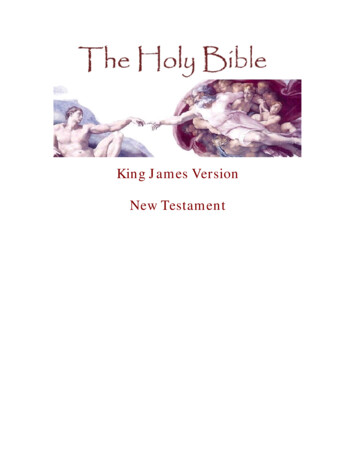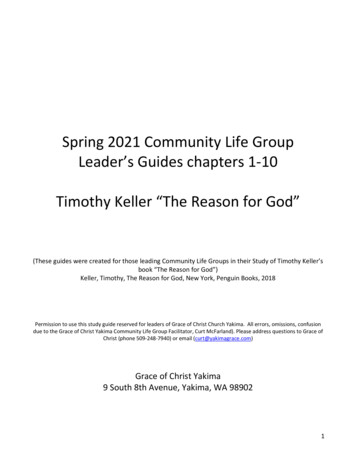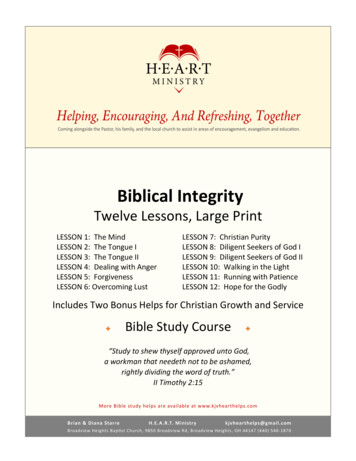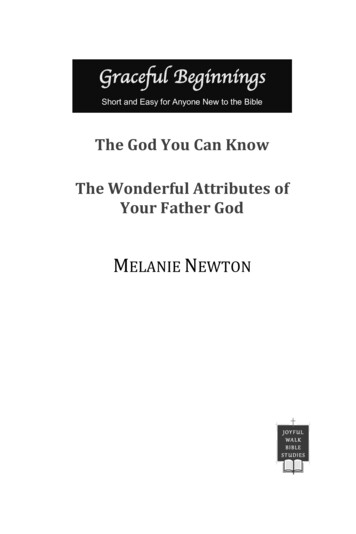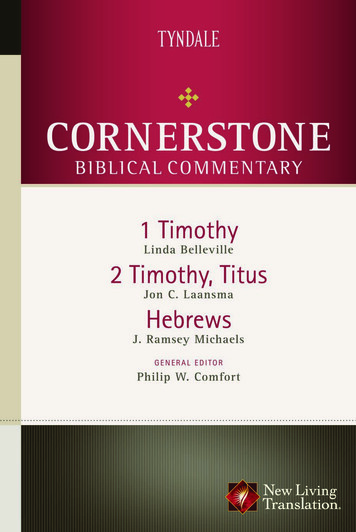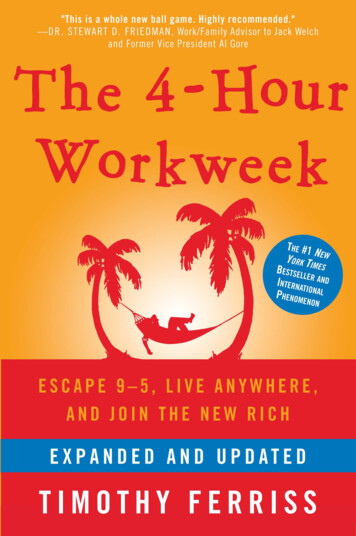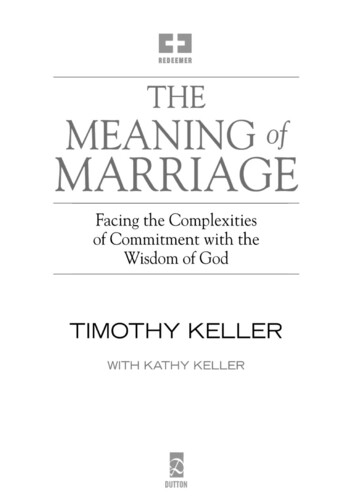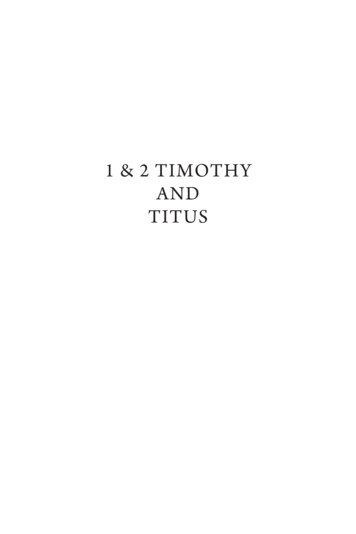
Transcription
1 & 2 TIMOTHYANDTITUS
BELIEFA Theological Commentaryon the Biblegeneral editorsAmy Plantinga PauwWilliam C. Placher†
1 & 2 TIMOTHYANDTITUSTHOMAS G. LONG
2016 Thomas G. LongFirst editionPublished by Westminster John Knox PressLouisville, Kentucky16 17 18 19 20 21 22 23 24 25—10 9 8 7 6 5 4 3 2 1All rights reserved. No part of this book may be reproduced or transmitted in any form or by any means,electronic or mechanical, including photocopying, recording, or by any information storage or retrievalsystem, without permission in writing from the publisher. For information, address Westminster JohnKnox Press, 100 Witherspoon Street, Louisville, Kentucky 40202-1396.Or contact us online at www.wjkbooks.com.Unless otherwise indicated, Scripture quotations are from the New Revised Standard Version of theBible and are copyright 1989 by the Division of Christian Education of the National Council of theChurches of Christ in the U.S.A. and are used by permission. Scripture quotations marked CEB arefrom the Common English Bible, 2011 Common English Bible, and are used by permission.Scripture quotations marked NIV are from The Holy Bible, New International Version. Copyright 1973, 1978, 1984, 2011 by Biblica, Inc. Used by permission. All rights reserved worldwide.Scripture quotations marked NKJV are from The New King James Version. Copyright 1979, 1980,1982, Thomas Nelson Inc., Publishers and are used by permission.Excerpt from “Stop Saying the Church Is Dying,” a sermon by Nadia Bolz-Weber, is reprinted bypermission of the author. All rights reserved. Excerpt from Our Town by Thornton Wilder. Copyright 1938 by The Wilder Family LLC. Reprinted by arrangement with The Wilder Family LLC andThe Barbara Hogenson Agency, Inc. all rights reserved.Book design by Drew StevensCover design by Lisa BuckleyCover illustration: David Chapman / Design Pics / CorbisLibrary of Congress Cataloging-in-Publication DataLong, Thomas G., 1946- , author.1 & 2 Timothy and Titus : a theological commentary on the Bible / Thomas G. Long.-- First edition.pages cm -- (Belief: a theological commentary on the Bible)Includes bibliographical references and index.ISBN 978-0-664-23262-7 (hardback) -- ISBN 978-0-664-26205-1 (pbk.) 1. Bible.Timothy--Commentaries. 2. Bible. Titus--Commentaries. I. Title.BS2735.53.L66 2016227'.8307--dc232015031928 The paper used in this publication meets the minimum requirementsof the American National Standard for Information Sciences—Permanence of Paper for Printed Library Materials, ANSI Z39.48-1992.
For George Leitz, who was my mentor inministry far more than he ever knew.
ContentsPublisher’s NoteixSeries Introduction by William C. Placherand Amy Plantinga PauwxiAcknowledgmentsxvIntroduction: Why the Pastoral Epistles? Why Now?1COMMENTARY1 TIMOTHY1 Tim.1 Tim.1:1–20Further Reflections: 1 Timothy and Patriarchy:The Empire Strikes Back?2:1–3:1a173757Further Reflections: The First Letter to Timothyand the Letter from the Birmingham Jail643:1b–16864:1–161051 Tim.5:1–6:2a1391 Tim.6:2b–211701 Tim.1 Tim.Further Reflections: The Later Times and the Night106of the Living DeadFurther Reflections: Food and Sex: Keeping It124between the Navigational Markers
viiiContents2 TIMOTHY2 Tim1:1–181832 Tim.2:1–3:91993:10–4:222282 Tim.Further Reflections: How Seriously ShouldWe Take the Pastor’s Alarm?234TITUSTitus1–3249Final Thoughts279Selected Bibliography283Index of Ancient Sources285Index of Subjects289
Publisher’s NoteWilliam C. Placher worked with Amy Plantinga Pauw as a generaleditor for this series until his untimely death in November 2008. Billbrought great energy and vision to the series, and was instrumentalin defining and articulating its distinctive approach and in securingtheologians to write for it. Bill’s own commentary for the series wasthe last thing he wrote, and Westminster John Knox Press dedicatesthe entire series to his memory with affection and gratitude.William C. Placher, LaFollette Distinguished Professor in Humanities at Wabash College, spent thirty-four years as one of WabashCollege’s most popular teachers. A summa cum laude graduate ofWabash in 1970, he earned his master’s degree in philosophy in1974 and his PhD in 1975, both from Yale University. In 2002 theAmerican Academy of Religion honored him with the Excellencein Teaching Award. Placher was also the author of thirteen books,including A History of Christian Theology, The Triune God, The Domestication of Transcendence, Jesus the Savior, Narratives of a VulnerableGod, and Unapologetic Theology. He also edited the volume Essentialsof Christian Theology, which was named as one of 2004’s most outstanding books by both The Christian Century and Christianity Todaymagazines.ix
Series IntroductionBelief: A Theological Commentary on the Bible is a series from Westminster John Knox Press featuring biblical commentaries writtenby theologians. The writers of this series share Karl Barth’s concernthat, insofar as their usefulness to pastors goes, most modern commentaries are “no commentary at all, but merely the first step towarda commentary.” Historical-critical approaches to Scripture rule outsome readings and commend others, but such methods only beginto help theological reflection and the preaching of the Word. Bythemselves, they do not convey the powerful sense of God’s merciful presence that calls Christians to repentance and praise; they donot bring the church fully forward in the life of discipleship. It is tosuch tasks that theologians are called.For several generations, however, professional theologians inNorth America and Europe have not been writing commentarieson the Christian Scriptures. The specialization of professional disciplines and the expectations of theological academies about thekind of writing that theologians should do, as well as many of thedirections in which contemporary theology itself has gone, havecontributed to this dearth of theological commentaries. This isa relatively new phenomenon; until the last century or two, thechurch’s great theologians also routinely saw themselves as biblical interpreters. The gap between the fields is a loss for both thechurch and the discipline of theology itself. By inviting forty contemporary theologians to wrestle deeply with particular texts ofScripture, the editors of this series hope not only to provide newtheological resources for the church but also to encourage allxi
xiiSeries Introductiontheologians to pay more attention to Scripture and the life of thechurch in their writings.We are grateful to the Louisville Institute, which provided funding for a consultation in June 2007. We invited theologians, pastors,and biblical scholars to join us in a conversation about what thisseries could contribute to the life of the church. The time was provocative and the results were rich. Much of the series’ shape owesto the insights of these skilled and faithful interpreters, who soughtto describe a way to write a commentary that served the theologicalneeds of the church and its pastors with relevance, historical accuracy, and theological depth. The passion of these participants guidedus in creating this series and lives on in the volumes.As theologians, the authors will be interested much less in thematters of form, authorship, historical setting, social context, andphilology—the very issues that are often of primary concern to critical biblical scholars. Instead, this series’ authors will seek to explainthe theological importance of the texts for the church today, usingbiblical scholarship as needed for such explication but withoutany attempt to cover all of the topics of the usual modern biblicalcommentary. This thirty-six-volume series will provide passageby-passage commentary on all the books of the Protestant biblicalcanon, with more extensive attention given to passages of particulartheological significance.The authors’ chief dialogue will be with the church’s creeds, practices, and hymns; with the history of faithful interpretation and useof the Scriptures; with the categories and concepts of theology; andwith contemporary culture in both “high” and popular forms. Eachvolume will begin with a discussion of why the church needs thisbook and why we need it now, in order to ground all of the commentary in contemporary relevance. Throughout each volume, textboxes will highlight the voices of ancient and modern interpretersfrom the global communities of faith, and occasional essays willallow deeper reflection on the key theological concepts of these biblical books.The authors of this commentary series are theologians of thechurch who embrace a variety of confessional and theological perspectives. The group of authors assembled for this series represents
xiiiSeries Introductionmore diversity of race, ethnicity, and gender than any other commentary series. They approach the larger Christian tradition with acritical respect, seeking to reclaim its riches and at the same time toacknowledge its shortcomings. The authors also aim to make available to readers a wide range of contemporary theological voicesfrom many parts of the world. While it does recover an older genreof writing, this series is not an attempt to retrieve some idealizedpast. These commentaries have learned from tradition, but they aremost importantly commentaries for today. The authors share theconviction that their work will be more contemporary, more faithful, and more radical, to the extent that it is more biblical, honestlywrestling with the texts of the Scriptures.William C. PlacherAmy Plantinga Pauw
AcknowledgmentsOf the many colleagues and friends who gave great help in the writingof this commentary, I want to express particular gratitude to fiveof them: Kimberly Wagner, my tireless and most capable researchassistant; New Testament scholars, friends, and conversationpartners, Luke Timothy Johnson and Steven Kraftchick; my dearand patient friend of many decades, Craig Dykstra; and my pastorduring my college years, George Leitz, who modeled faithfulministry for me and to whom this volume is dedicated.xv
Introduction:Why the Pastoral Epistles?Why Now?The “Pastoral Epistles” (which is the name by which the letters 1Timothy, 2 Timothy, and Titus have collectively been called sincethe eighteenth century) are among the most neglected books of theNew Testament. Most pastors have preached from these letters onlyrarely, and they are usually explored only lightly, if at all, in Biblestudies. Although they present themselves as letters from the apostlePaul to two of his young pastoral protégés, Timothy and Titus(thus the name—the “Pastoral Epistles”), they were almost surelywritten several decades after Paul’s death, and their main focus is onestablishing—or reestablishing—order, discipline, and theologicalsoundness in congregations that have gone—or are threatening togo—off the rails.The fact that congregations sometimes get into trouble,occasionally escalating to nasty church fights, and require remedialintervention is nothing new, of course, but it rarely makes forstirring and inspirational reading. As one accomplished preachersaid of the Pastoral Epistles, “Frankly, they’re not my go-to books.”That’s understandable. We would rather read accounts of the churchcruising smoothly down the highway of faith, proclaiming the gospelfaithfully, compassionately showing the love of Christ, standing tallfor social justice. In the Pastoral Epistles, though, we see the churchon the mechanic’s lift in the garage, and we are given guidance forperforming an ecclesial engine overhaul.Ironically, though, the very traits that have caused the Pastoralsto be overlooked by earlier readers may, in fact, make them urgentlyimportant for readers today. In a time when churches were full1
2INTRODUCTIONand relatively prosperous, it was easy to imagine that healthy andconfident congregations were the norm and troubled churches theexception. But in North America now the picture has drasticallychanged; it is the whole church that is in trouble. The membershipnumbers for traditional denominations are in precipitous decline,and most local congregations are becoming grayer, smaller, andsometimes discouraged. The preferred religious choice among manyof our youth is “none of the above,” and churches with impressivebuildings that once housed large and vibrant Sunday congregationsnow find only a handful gathered for worship. People look aroundat the vacant pews and wonder, “What happened? Where are theyoung people? Are we dying?”Even congregations that have bucked the trend and seem to begrowing and strong are often confused about what it means to liveas Christians in the fragmented culture in which we find ourselvestoday. The lines marking off the difference between healthy andunhealthy congregations are often blurred: many worship spaceslook and feel more like pop concert arenas and entertainmentvenues than sanctuaries, some churches operate more like corporateentities than pilgrim communities, people seem to know moreabout the lives of superficial celebrities than they do of the saints,and North American Christianity sometimes seems more beholdento consumerist values than to the gospel.One could despair about all this church decline and wonder whyGod doesn’t put a stop to it. Or, more fruitfully, one could take atheological view of this shaking of the foundations. The church aswe have known it is under stress, but maybe God doesn’t stop thepressure and the upheavals because God started it. As Ecclesiastessays, there is “a time to break down, and a time to build up.” We doknow, at the very least, that God is in the middle of the church’sturmoil, tearing down what we have known in order to build up achurch more faithful and full of life.And that is where the Pastoral Epistles come into play. Some ofthe issues faced in these letters are our issues once again—the lureand peril of “spirituality” for Christians, the character of authenticworship, the qualities needed for sound leadership, the relationshipbetween family life and the “family” of the church. And even in those
Why the Pastoral Epistles? Why Now?3matters in these letters that seem remote from our current situation,the author approaches them with the elements we need as we addressour own challenges: a love for the church, a firm gospel compassin hand, and a clear and courageous voice. As Christians in NorthAmerica venture out from the ruins of the churches we once knewseeking new ways of being church, the Pastoral Epistles can refreshour memory about what really counts in Christian community andthe profound importance of trustworthy leaders.Hearing these ancient documents as wisdom for our day willrequire a generosity of spirit on our part. Taken at face value, thePastoral Epistles have some jagged edges and tend to divide thehouse. On the positive side, these three letters, unlike other NewTestament epistles, are addressed to individuals rather than churchesor groups of people, and they often bear the marks of a tender andloving personal correspondence. Also, there are passages in theseletters that soar in beauty and theological power, for example themoving portrait of Paul at the end of his life as one who has “foughtthe good fight . . . finished the race . . . kept the faith” (2 Tim. 4:7) orthe encouragement given to Timothy as a pastor to reclaim the zealfor ministry that was there on the day of his ordination, “to rekindlethe gift of God that is within you through the laying on of my hands”(2 Tim. 1:6). Reverberating through these letters is a love for thegospel and for the church, which finds expression in a yearning thatall of the faithful would “take hold of the life that really is life” (1Tim. 6:19).On the negative side, however, there is a concern for churchorder and decorum in these letters that many readers find brittle andstern, perhaps even repressive. Beyond this, some of the instructiongiven in the Pastorals is quite conventional, reflecting typical codesof behavior expected in Greco-Roman households of the era ratherthan a new gospel-inspired ethic. The writer of these letters seemsat times to forget, or perhaps ignore, his own teaching about thetransformative power of Christ. Other teaching in these letters isdownright shocking, even repugnant, to readers today. For example,the author says, “I permit no woman to teach or to have authority overa man” (1 Tim. 2:12), and he advises, “Tell slaves to be submissiveto their masters . . .” (Titus 2:9). Also, the author sometimes does
4INTRODUCTIONnot mind his tongue, speaking of some members of the communityas “silly women” (2 Tim. 3:6) and seeming to agree with the slurthat all people from the island of Crete are “liars, vicious brutes, lazygluttons” (Titus 1:12).How do we approach these letters, then, which both attract andrepel at the same time? Some of the reading strategies that I havechosen to employ in this commentary are as follows:1. To read the Pastoral Epistles in their own context, that is, in light ofthe circumstances, issues, and possibilities inherent in the situation beingfaced by the author.In Sierra Leone in the 1950s, the noted church historianAndrew Walls began his long teaching career. Being at that timea young and aspiring professor with an Oxford and Cambridgepedigree, Walls delivered learned lectures to his African studentson the documents and history of the early church. They dutifullytook notes, but, as Walls says, “You could see from their faces thatit didn’t penetrate.”1But then Walls made a startling discovery. He began to worshipin local African Christian congregations, went to meetings withthe Sierra Leonean pastors, and immersed himself in the life ofthe indigenous churches. One day in the classroom, when he waslecturing to his students about the second-century church, itsuddenly struck him that he “was actually living in a second-centurychurch.”2After that moment of insight, Walls read the documents of theearly second-century church with new eyes, aware now that hewas looking at living examples of that literature all around him.He read, for example, the long sermon-like document known as 1Clement and would recognize that he had heard similar sermons inthe African context. “Yes,” he said, “I’d hear sermons like that, andjust as long.” He read Ignatius on martyrdom, “and though I had notactually seen anybody going to martyrdom, you saw the same sort of1. Tim Stafford, “Historian Ahead of His Time,” Christianity Today, 51/2 (February 2007): 88.2. Ibid.
Why the Pastoral Epistles? Why Now?5intensity.”3 He said to himself, “Why did I not stop pontificating andobserve what was going on?”4Reading the Pastoral Epistles with insight and understandingrequires, I think, a similar shift in perspective. As readers, we haveto imagine our way into a late first-century Christian community inAsia Minor. Reading these letters in context does not mean forgoingour own judgments about what these texts finally say to us, to ourfaith, and to the church in a quite different world today, but it doesmean suspending that judgment long enough to try to make anempathetic connection to the author in his own time and place. Weread these letters keeping in mind novelist L. P. Hartley’s famousdictum, “The past is a foreign country: they do things differentlythere.”5I have written this commentary while serving on the faculty ofa university divinity school in the United States, a school in whichmen and women in roughly equal numbers are preparing forpositions of responsibility and religious leadership. Our faculty andstudents come from all over the world, represent many theologicaltraditions, and are of many ethnicities, backgrounds, and theologicalworldviews. We are located in the American South, and some of ourstudents are the descendants of nineteenth-century African slaves,while others are the great-great-grandchildren of slave owners.Some of our students are heterosexual and others are homosexual,all preparing for ministry in a time when church attitudes and rulesare changing rapidly and dramatically.In other words, I live in an environment where the churchseems global, multicultural, and complex, and major change seemsnot only possible but inevitable and desirable. Not only that, thecommunity in which I work is filled with people who see themselvesas empowered to create that change and as called to help transformthe world toward ever more just societies. We are aware of our past—its rich traditions and its shameful times and historical burdens—but we are also aware that the future can and must be different. Inshort, when some social structure is out of alignment with the values3. Ibid.4. Ibid.5. L. P. Hartley, The Go-Between (New York: New York Review of Books, 2002), 17.
6INTRODUCTIONof the gospel, whether it be the government, the economic system,the church, or even the theological school itself, we see ourselves ashaving the responsibility to do all we can to change the world andmake it right.It would be easy to think that the author of the Pastoral Epistlesoperated in such a world as ours, but he did not. In his world, tobe sure, some things could be changed, but the basic structures ofsociety were seen as much more fixed and permanent than we viewthem. In our world, young people can flash messages over socialmedia, gather a crowd in a public square, and eventually accomplishthe almost unthinkable: topple a government. The author of thePastorals, however, could not envision such a possibility, Therewould, for example, always be an emperor. One could imaginemany ways of relating to the emperor—pray for the emperor, notpray for the emperor, pray to the emperor, refuse to pray to theemperor, obey the emperor, resist the emperor, die for the emperor,die at the hands of the emperor—but a world without an emperor?Unimaginable. Therefore, the author of the Pastorals, given hiscontext, will consistently offer advice about how to move the pieceson the chessboard. We sometimes lose patience with him becausewe expect him to throw out the chessboard and to change the gameitself.Two experiences in particular have given additional shape tomy understanding of the context of these letters. First, before Ibecame a seminary teacher, I briefly served as the pastor of a smallcongregation, long enough to discover the difference between thegospel expressed in pure terms and the gospel as actually lived outin the messy lives of people and congregations. In times of calm andwhen I was at my pastoral best, I could speak to my congregation asa caring shepherd, with grace, patience, and compassion. But therewere other times when some brush fire had broken out in the church,and, desperate to keep the fire from spreading, I could hear myselfbarking shrill orders like a desperate fire chief. Just so, the author ofthese letters is not writing as a systematic theologian. He is writingas a pastor to real congregations, congregations in trouble, and thebrush fires are starting to spread. As New Testament scholar JohnP. Meier said, “The Pastorals are often accused of being pedestrian
Why the Pastoral Epistles? Why Now?7and bourgeois. As every bishop knows, they are simply realistic.”6Therefore, when the mood suddenly darkens in these letters and theauthor’s voice becomes bossy or even caustic, I don’t always respondwith joy or appreciation, but as a former pastor myself, I do think Iunderstand.I remember some years ago seeing, on one of the networktelevision morning news shows, an interview with a learnedpsychiatrist. He had just written a wise and compassionate bookabout his years working in a psychiatric hospital and treating patientswith severe mental illness. At one point in the interview he recalledhaving seen, in his days as a young medical student, the movie OneFlew over the Cuckoo’s Nest. In the film, Jack Nicholson plays the partof R. P. McMurphy, a small-time criminal who fakes insanity to getout of prison work duty. He is transferred to a psychiatric hospital,which is ruled over by the formidable, stern, and inflexible NurseRatched. To the delight of the movie audience, McMurphy ends upleading a spirited rebellion among the patients against her and herrigid rules. Because of the movie (and the Ken Kesey book on whichit was based), the name “Nurse Ratched” is now cultural shorthandfor oppressive authoritarianism.The psychiatrist being interviewed said that when he first saw themovie that he, like almost everyone else, “hated Nurse Ratched.”She came across as mean, obstinate, and hidebound. But then thepsychiatrist, somewhat tongue in cheek, quipped, “Now that I amolder, however, and have spent my whole medical career dealingwith severe psychiatric cases, I have a deep appreciation for her andher work!” Just so, experience in trying to lead real and challengingcongregations can soften how we understand the seemingly sternauthor of these letters.Second, while I have not had the extensive experience outsideof North America that others, such as Andrew Walls, have had,occasional opportunities to teach and do church-related work inwhat are sometimes called “less-developed” parts of the globe havetuned my ear somewhat to the problems and issues in these letters.There are many churches in the world today that in important6. John P. Meier, “The Inspiration of Scripture: But What Counts as Scripture? (2 Tim 1:1–14;3:14–17; cf 1 Tim 5:18),” Midstream 38/1–2 ( January–April, 1999): 76.
8INTRODUCTIONways are more like the late first-century congregations of thePastorals in form and outlook than they are like their contemporarycounterparts in Chicago, Dallas, Minneapolis, or San Francisco.In these congregations, gender roles are complex but have firmerboundaries and definition than they do generally in North America,the lines between Christian and non-Christian belief and practiceare more sharply drawn than many North American Christiansare accustomed to drawing, and communication is carried moreinformally—by word-of-mouth as people travel from one smallchurch gathering to another. When I see the author of the Pastoralsgetting in a knot over whispers and rumors being spread by some ofthe women as they move about in the community, I realize I haveseen similar communication patterns—and problems—amongchurches today set in village societies. Gossip can be a problemin any congregation no matter where it is located. But in thesecongregations, gossip—regardless of the gender of its source—isnot simply a nuisance; it can become the primary means of formingattitudes. Left unchecked, it can bring the church to its knees, andnot in prayer. These congregations breathe much of the same airas the churches of the Pastorals, and awareness of them has helpedtune me to the context of these letters.2. To read the Pastoral Epistles as Scripture.Reading these letters as Scripture does not mean suspendingone’s critical faculties. In fact, it could be argued that reading thesetexts as holy Scripture requires the sharpening of critical faculties.But to read these documents as Scripture does mean recognizingthat the church has included them in the canon of Scripture because,through the centuries, it has heard gospel in them and found its lifeformed by them more fully into the pattern of Jesus Christ.What this kind of reading involves—and this is an often difficultassignment for a person of my temperament—is openness,generosity, and humility. As biblical scholar Ellen Davis hascommented about the task of reading difficult biblical texts,The difficult text is worthy of charity from its interpreters.Interpretive charity does not mean pity but rather somethingmore like generosity and patience toward the text. . . .
Why the Pastoral Epistles? Why Now?9Charitable reading requires considerable effort; it is easierto dispense with the difficult text. Those who regard a textas religiously authoritative are willing to sustain that effort,because they perceive it in some sense as a gift from God.7If we understand these letters, then, to be more than artifacts ofsecond-generation Pauline ecclesiology, but to be in some sensegifts from God, then at the end of the day we may throw up ourhands in despair about this or that passage, unable to see how sucha word has any divine gift in it. But we will do so only at the endof the day, not at the beginning. We will sit for a long day, dwellinghumbly with these texts, listening for the gift that God wishes togive through them. More practically, we will consider each passagein these letters to consist of the intersection of the gospel and someconcrete circumstance in a late first-century Christian community.Sometimes we will be able to hear the gospel word clearly. Othertimes, though, the circumstance will shout more loudly than thegospel; so, denied a clear word, we will look instead for the trajectoryof the gospel, the difference it made in the situation.I say this because the Pastoral Epistles have more than their shareof unsympathetic readers. To be sure, if one wishes to see theseepistles as unfortunate examples of the ossification of the oncevibrant early church, or as documentary evidence of the resurgenceof a powerful and rigid patriarchy, or as a heavy-handed impositionof conventional Greco-Roman domestic ethics on the Christiancommunity, there is plenty of material in these letters to make adamning case. But to read the Pastoral Epistles as Scripture is to takeon two roles. We do serve, temporarily, as the prosecuting attorney,putting these texts to the test. But finally we stand as the defenseattorney. We expose these documents to the critical gaze. Theycan take it. But in the end, we come around to do what we can toadvocate for them. The good interpreter of Scripture does not makea false case for the text but does work hard to make the best case forthe text. As Jewish philosopher Moshe Halbertal has argued,7. Ellen F. Davis, “Critical Traditioning: Seeking an Inner Biblical Hermeneutic,” i
studies. Although they present themselves as letters from the apostle Paul to two of his young pastoral protégés, Timothy and Titus (thus the name—the “Pastoral Epistles”), they were almost surely written several decades after Paul’s death, and their main focus is on establis
